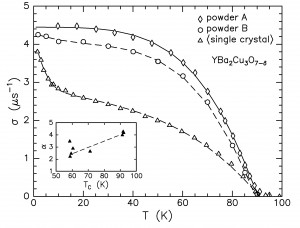Concerning the Superconducting Gap Symmetry in YBa2Cu3O7–δ, YBa2Cu4O8, and La2–xSrxCuO4 Determined from Muon Spin Rotation in Mixed States of Crystals and Powders, D. R. Harshman and A. T. Fiory [arXiv]
Muon spin rotation (μ+SR) measurements of square root second moments of local magnetic fields σ in superconducting mixed states, as published for oriented crystals and powder samples of YBa2Cu3O7–δ (δ ≈ 0.05), YBa2Cu4O8 and La2-xSrxCuO4 (x ~ 0.15–0.17), are subjected to comparative analysis for superconducting gap symmetry. For oriented crystals it is shown that anomalous dependences of σ on temperature and applied field H, as-measured and extracted a– and b-axial components, are attributable to fluxon depinning and disorder that obscure the intrinsic character of the underlying superconducting penetration depth. Random averages derived from oriented crystal data differ markedly from corresponding non-oriented powders, owing to the weaker influence of pinning in high-quality crystals. Related indicators for pinning perturbations such as non-monotonic H dependence of σ, irreproducible data and strong H dependence of apparent transition temperatures, are also evident. Strong intrinsic pinning suppresses thermal anomalies in c-axis components of σ, which reflect nodeless gap symmetries in YBa2Cu3O7–δ and YBa2Cu4O8. For YBa2Cu3O7–δ, the crystal (a–b components, corrected for depinning) and powder data all reflect a nodeless gap (however, a–b symmetries remain unresolved for crystalline YBa2Cu4O8 and La1.83Sr0.17CuO4. Inconsistencies contained in multiple and noded gap interpretations of crystal data, and observed differences between bulk μ+ and surface-sensitive measurements are discussed.
D. R. Harshman and A. T. Fiory, J. Phys.: Condens. Matter 23, 315702 (2011).












